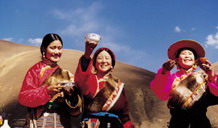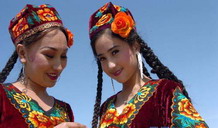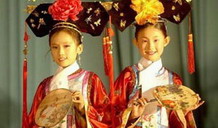Main Customs of the Mongolian People
Mongolians grow up on horseback. and love to show off their horsemanship, archery, and wrestling skills.
"Nadam," meaning games in Mongolian, is the name of a traditional Mongolian fair, which is held each July and August. At the fair, people wearing their holiday best, participate in horse racing, archery, singing, dancing, chess playing and wrestling.
Mongolians living in pastoral areas wear fur coats in the winer, either unlined or lined with satin or cloth, and loose, long-sleeved cotton robes in summer. Mongolian clothing is generally red, yellow or dark blue in color. A red or green waistband, flint steel, snuffbox and knife in an ornate sheath for cutting meat are accessories commonly owned by all men and women. Knee-high felt boots are a type of common footwear. Men and women wear cone-shaped hats in winter; they also like to wear silk or cloth turbans. Girls wear their hair parted in the middle, embellished with two large beads and agate, coral and green jade ornaments.
In pastoral areas, beef, mutton and dairy products are the staple food, while in the farming areas, people like to eat grain. Tea is indispensable. Dried cow dung is a common cooking fuel.
Mongolian herdsmen used to live in felt yurts, which were usually 7-8 feet high and 10 feet in diameter. With an opening in the top of the umbrella-shaped roof, they give ideal ventilation and good protection against wind and cold.
After the mid-20th century, as more and more herdsmen ended their nomadic life and settled down, they began to build yurt-like houses of mud and wood and one-storied houses, each with two or three rooms like those in other parts of the country.
Mongolians welcome strangers traveling on the grasslands to stay for the night in their yurts and treat them to tea with milk, mutton and milk wine, before giving them a warm send-off.






